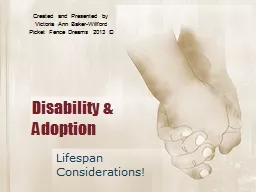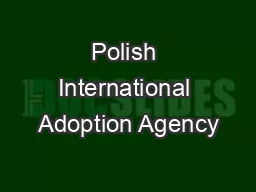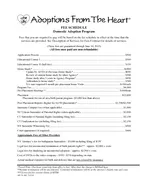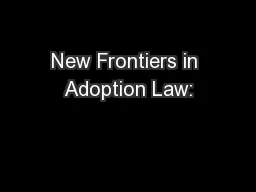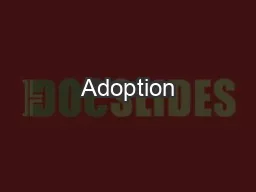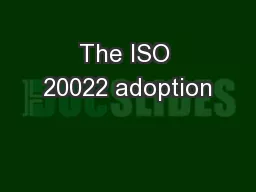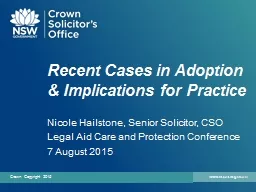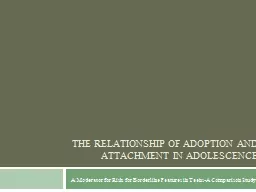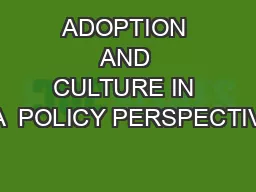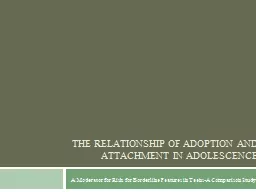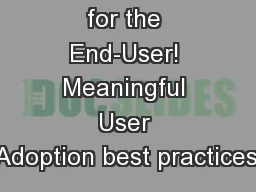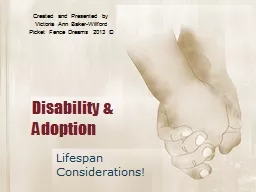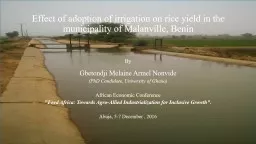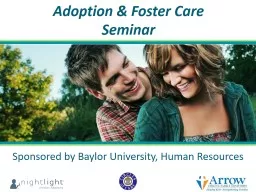PPT-Disability & Adoption
Author : marina-yarberry | Published Date : 2017-07-11
Lifespan Considerations Created and Presented by Victoria Ann BakerWillford Picket Fence Dreams 2013 Disability disability noun plural disabilities 1 lack of
Presentation Embed Code
Download Presentation
Download Presentation The PPT/PDF document "Disability & Adoption" is the property of its rightful owner. Permission is granted to download and print the materials on this website for personal, non-commercial use only, and to display it on your personal computer provided you do not modify the materials and that you retain all copyright notices contained in the materials. By downloading content from our website, you accept the terms of this agreement.
Disability & Adoption: Transcript
Lifespan Considerations Created and Presented by Victoria Ann BakerWillford Picket Fence Dreams 2013 Disability disability noun plural disabilities 1 lack of adequate power strength or physical or mental . A Precious Gift Adoption Resource Center is a PA not-for-profit corporation founded by two women with unique adoption experiences. We are a progressive, non-traditional licensed adoption agency in northeast Pennsylvania. Because of our unique personal experiences in adoption, A Precious Gift ARC can provide a deep understanding of your fears and concerns and dreams and desires about the adoption process. It is important for you to know that we share your ethical standards and moral convictions as it relates to adoption. The Founder and President of the agency, Lina Ratcheva, is a strong Christian. She built the agency on Christian principles. Personally, she believes that everything is part of God’s plan and Saint Mary’s is just a tool in carrying out His plan to save orphans and build families through the miracle of international adoption. Open adoption provides children and adoptive families access to medical records and accurate information about birth families and allows birth parents the opportunity to s elect the adoptive parents for their children Open adoption arrangements vary Adoption by Civil Partners and Same-sex Couples. Dr Fergus Ryan. Department of Law, . Maynooth. University . (National University of Ireland Maynooth). Purpose. To address the topic of adoption as it relates to potential adopters who are not married to each other, in particular LGBT people and same-sex couples, and to the children for whom they care or whom they may propose to adopt. . By: Nicole Huwe. Introduction. What is adoption?. Why I chose adoption?. How I feel about my topic. Will it be a part of my life in the future?. What new skills did I learn? . What did I learn . about myself? . mApp. . Download the . mApp. on your . iPad. !. ISO 20022. Brought to you by the ISO 20022 Registration Authority. . . A free IOS tablet app, . that provides an overview of initiatives . Nicole Hailstone, Senior Solicitor, CSO. Legal Aid Care and Protection Conference. 7 August 2015. Out of home care adoptions. Intercountry adoptions. Relative or step-parent adoptions. Special case adoptions. A Moderator for Risk for Borderline Features in Teens-A Comparison Study. Reasons for Study-General. Previous adoption studies have focused on :. generalized studies comparing adoptees to their non-adoptee counterparts only across developmental domains: school achievement, physical health, social development capacity . WHAT IS ADOPTION. Adoption i. s . a legal process . whereby . parental powers, rights . & responsibilities . of . the . biological parent/s over a child are revoked or . terminated; & . vested in another person/s, namely the adoptive . A Moderator for Risk for Borderline Features in Teens-A Comparison Study. Reasons for Study-General. Previous adoption studies have focused on :. generalized studies comparing adoptees to their non-adoptee counterparts only across developmental domains: school achievement, physical health, social development capacity . Jussi Mori, Cloudriven GmbH, @JussiMori. Marcel Haas, Cnext GmbH, @cNext_HaasMa. <Whoami>Jussi Mori</Whoami>. Co-Founder Cloudriven GmbH. Office Server and Services MVP 2013 - 2016. Organizer SharePoint Saturday Helsinki and Zurich. Lifespan Considerations!. Created and Presented by. Victoria Ann Baker-Willford. Picket Fence Dreams 2013 ©. Disability. dis·a·bil·i·ty. noun. , plural dis·a·bil·i·ties . . 1. . lack of adequate power, strength, or physical or mental . By. Gbetondji. Melaine Armel . Nonvide. (PhD Candidate, . University. of Ghana). African . Economic. . Conference. "Feed Africa: Towards Agro-Allied Industrialization for Inclusive Growth". . Abuja, 5-7 . Seminar. . .. Sponsored by Baylor University, Human Resources. Baylor University. Adoption Assistance Program. What does it offer?. Up to $10,000 (previously $6,000) in reimbursement of Qualified Adoption Expenses that are paid or incurred in connection with the final adoption of an Eligible Child and while an Eligible Employee under the Program..
Download Document
Here is the link to download the presentation.
"Disability & Adoption"The content belongs to its owner. You may download and print it for personal use, without modification, and keep all copyright notices. By downloading, you agree to these terms.
Related Documents

